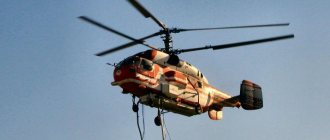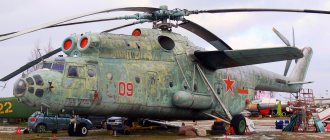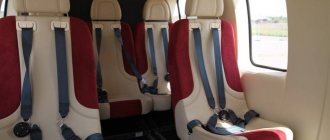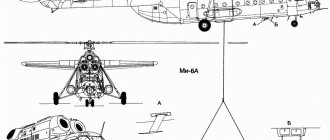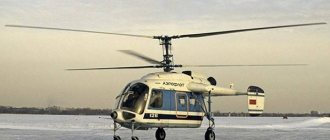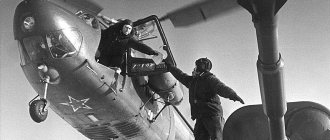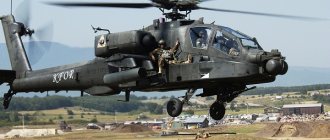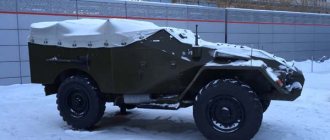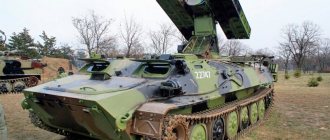Search and rescue and anti-submarine helicopter Ka-27
rotorcraft warrior
Today, it is difficult to find a large warship in any navy that is not equipped with a helicopter. The latter are mandatory support for military vessels, significantly increasing their combat capabilities. The team of the Polygon program of the T24 TV channel visited the village of Donskoye near Kaliningrad, where the 396th separate naval anti-submarine squadron is located - a base for search and rescue and anti-submarine Ka-27 helicopters. The film crew was able to get acquainted not only with the technical characteristics of rotary-wing warriors, but also to fly a helicopter, and also take part in an operation to search for and destroy a mock enemy submarine.
Heroes of our time
Can the same helicopter model be equally good for rescue, for destroying submarines, and for reconnaissance?
The T24 TV channel team answers this question in the affirmative - they were able to verify this with their own eyes. The Ka-27 helicopter has two modifications with diametrically opposed tasks: the Ka-27PS is engaged in the search and rescue of crews in distress on land or at sea, and also performs aerial reconnaissance. The Ka-27PL modification is designed to search, track and destroy enemy submarines. The Ka-27PL belongs to the class of heavy vehicles and has a maximum take-off weight of about 11 tons. The crew consists of three people: a pilot, a navigator and a navigator-operator of anti-submarine systems. The Ka-27 submarine can detect, track, and then destroy objects at a depth of up to 500 meters. From its home base, be it a ship or a heliport, the Ka-27 submarine can move 200 kilometers away without losing the information channel.
In the crew of the search and rescue modification, the pilot and navigator are reinforced by a flight engineer and a paramedic-rescuer. The Ka-27 PS is capable of carrying up to 12 people. The flight technician and paramedic-rescue worker act in tandem: the flight technician lowers and controls the electric winch, and the paramedic selects and provides medical assistance.
The all-metal fuselage of air fighters is made of aluminum alloys. To ensure longitudinal and directional stability, a tail unit with two keels is equipped. In the aft part of the fuselage there is a compartment for a hydroacoustic station - the main working tool of an anti-submarine helicopter. The search and rescue version does not have this equipment. The helicopter is equipped with a cargo winch, which allows lifting and lowering cargo and evacuating people from hard-to-reach places.
Higher and higher and higher
The helicopter control system includes the main handle, which the pilot always holds, it is connected by rods to the lower rotor swashplate, there is a path control with pedals, and finally, a collective pitch handle that changes the angle of attack of the blades.
Before the flight, each helicopter undergoes mandatory training: the condition of radio engineering and radio communication devices, the serviceability of the engine, aviation and radio-electronic equipment, as well as anti-submarine search equipment and aircraft weapons are checked.
The helicopter's stable position in the air is ensured by two three-blade counter-rotating propellers. On the Ka-27, both rotors are rotors and both are deflected in the plane for control. A load-bearing element, a spar, made of ultra-strong laminated carbon fiber passes along the length of the entire structure. The KA-27 can accelerate to 270 km/h, although the usual speed is 220 km/h. These rotorcraft can overcome an altitude of 3000 meters without any problems. The practical flight range is 900 kilometers.
Aerial hunting
Naval aviation is especially demanding in terms of precision of maneuvers - when landing on the deck of a moving ship, dozens of parameters must be taken into account.
And if we are talking about bombing or torpedoing submarines, then combat approaches and turns are simply an obligatory part of the program. The ships and two Ka-27 helicopters are connected to a common information network and when a submarine is detected, all participants in the operation will receive its coordinates. In this case, the actions of the helicopter are controlled by the commander of the ship-search strike group. To destroy submarines, AT-1MV anti-submarine torpedoes, APR-23 missiles and PLAB free-fall anti-submarine bombs of 50 and 250 kg caliber can be suspended. Naval aerial bombs are mounted on the side of the Ka-27 hull; there are day and night versions.
Remembering the Greek myth about the rescue of Andromeda from the clutches of a sea monster, you understand that it is not easy to be Perseus. It is difficult to simultaneously fight sea creatures, save those who are dying, and at the same time not harm yourself. However, the Ka-27 helicopter copes well with the assigned tasks of identifying and eliminating the enemy, as well as saving human lives. The Polygon team of the T24 TV channel now knows this for sure.
Armament
To destroy submarines, AT-1MV anti-submarine torpedoes, APR-23 missiles and aerial bombs weighing 50 and 250 kg can be suspended.
On the KD-2-323 cassette holder installed on the right side of the fuselage, OMAB orientation naval bombs, day or night, are suspended.
Search and targeting system "Octopus"
The Octopus onboard equipment includes:
- a radar station, the radome of which is located in the forward part of the fuselage (provides the solution of navigation problems, detection of submarines on the surface), and transponder radio beacons;
- a lowered hydroacoustic station located in the rear of the fuselage (provides detection and determination of the coordinates of the submarine);
- sighting and computing device for automatically launching a helicopter to the point of release of weapons;
- sonobuoy
- magnetic detector.
In addition, markers, smoke generators and radio transponder beacons can be installed.
Detection range of surface targets when flying at an altitude of 100-500 m:
- with an EPR of 250 m - no less than 25 km;
- with an EPR of 2 m - at least 5 km;
Detection range of an underwater target of the diesel-electric submarine type pr.613 at a speed of 6-8 knots, a depth of 100 m, sea state 2 points - 8 km
Distinctive features of the Octopus PPS are an information and computing subsystem based on an on-board digital computer, a tactical situation indicator, the ability to mutually orient helicopters as part of a tactical group, and a high degree of automation of the boat search process.
The onboard automated system “Privod-SV-bort”, together with the navigation complex and ship equipment, was intended to solve a wide range of tasks related to helicopter navigation and maneuvering (operating modes “navigation” and “landing”).
History[edit]
Helicopter prototype «252»
took off on August 8, 1973, and made its first circling flight on December 24.
Serial production began in 1977 at the helicopter plant in Kumertau. For various reasons, testing and development of the helicopter lasted for 9 years, and the helicopter was accepted into service on April 14, 1981.
The first 5 production helicopters entered service with the Minsk aircraft carrier in the fall of 1978.
In 1979, as part of the Northern Fleet at the Severomorsk-2 airfield, a regiment of naval helicopters (830 OKPLVP) equipped with the Ka-27 was formed. Later, all Project 1143 aircraft-carrying ships received Ka-27 helicopters.
On April 14, 1981 it was put into service.
Currently, the Ka-27 continues to serve on the Admiral Kuznetsov aircraft carrier. One helicopter each is armed with Project 956 destroyers and Project 1164 missile cruisers, two each with Project 1155 BODs and Project 1144 missile cruisers. It should be noted that the main location for helicopters is not ship hangars, but coastal airfields of Naval Aviation.
The helicopter was exported to India, China, Syria, Yugoslavia in the export modification Ka-28
.
Construction[edit]
The supporting system is built according to a coaxial scheme. The propellers are three-bladed, counter-rotating, folding back like a fan when docked. The propeller blades are made of fiberglass, the blade bushings are made of titanium.
The fuselage is all-metal, made of aluminum alloys, beam-stringer type. To ensure longitudinal and directional stability, a tail unit with two keels is installed. Each fin washer is equipped with an uncontrolled slat and is turned with its toe towards the fuselage axis.
The landing gear is four-support, non-retractable, equipped with a hydraulic helicopter lifting system for easy access to the cargo compartment. The front wheels are self-orienting. Ski installation possible.
The power plant consists of two TV3-117KM turboshaft engines with a total take-off power of 2x2200 hp. and gearbox VR-252. The rotational speed of the main rotors in flight is stabilized. The AI-9 APU is used as a power unit for starting engines.
Ka-27PL at the Army-2017 forum
The main sources of electricity are two three-phase alternating current generators 200 V 400 Hz type GT40PCh8B, driven by a VR-252 gearbox. The generators operate in parallel and in phase, but only the left one is connected to the on-board network, and the right one is a backup. There are no direct current generators on the helicopter, and the direct current into the general network of 28.5 volts is converted from three-phase alternating current 200 volts by two semiconductor rectifier devices VU-6B. The 36 V 400 Hz network is powered by two step-down transformers. Emergency sources are two nickel-cadmium batteries 20NKBN-25U3 and two static semiconductor current converters POS-1000A and PTS-800A.
During an emergency landing on water, inflatable ballonets are used, which in the stowed position are rolled up and placed in containers on the sides of the fuselage (ballonets do not provide acceptable buoyancy when the engines are stopped). The volume of the ballonet is 5.4 m³, inflation occurs from cylinders with compressed air (the cylinder taps are pyrotechnic).
The helicopter is equipped with a PKV-252 helicopter flight control system and an NKV-252 navigation system. PKV-252 allows you to perform automated hovering of a helicopter according to the indications of the director instrument, automatic hovering of a helicopter with height stabilization along the released length of the cable rope and its angle of inclination. The complex includes a four-channel electro-hydraulic autopilot VUAP-1, a gyrovertical, sensors for angular velocity, immersion depth of an acoustic receiver, an indicator of hovering parameters, etc. The complex interacts with a Doppler ground speed and drift angle meter, Drive equipment, a heading system and an airspeed sensor.
The main anti-submarine equipment of the helicopter is the Octopus search and targeting system, which is formed by four subsystems: hydroacoustic, radar, navigational and tactical situation indication, information and computing (see below).
The A-100 “Pakhra” receiving and indicator device (RID) provides a panoramic automatic view of the deployed buoys, monitoring their performance and listening to sea noises.
The crew consists of three people: a pilot, a navigator (navigator) and a navigator-operator (search and sighting complex).
Operating countries[edit]
In service[edit]
- Russia Aviation of the Russian Navy - 63 Ka-27 and 16 Ka-27PS, as of 2020.
- Border Service of the Federal Security Service of the Russian Federation - no more than 20 Ka-27PS units, as of 2016.
- Aviation of the Ukrainian Navy - more than 4 Ka-27, as of 2016.
- Vietnamese Navy aviation - 10 Ka-28, as of 2020.
- Indian Navy Aviation - 12 Ka-28, as of 2020.
- Aviation of the Chinese Navy - 19 Ka-28, as of 2020.
- Syrian Navy - 4 Ka-28, as of 2020.
- Algerian Navy - 3 Ka-27PS, as of 2020.
- Yemeni Armed Forces - a number of Ka-27s, as of 2020.
Was in service[edit]
- USSR
Aviation of the USSR Navy - was in service until the collapse of the country in 1991.
- Air Force of the SFR of Yugoslavia - the Ka-28 was in service with the 784th squadron of anti-submarine helicopters of the 97th aviation brigade, based at the air base in Divulja and intended for coastal operations and support of the Navy of the SFR of Yugoslavia. In addition to the Ka-28, the squadron was armed with the Ka-25 and Mi-14.
- Revolutionary Cuban Navy
